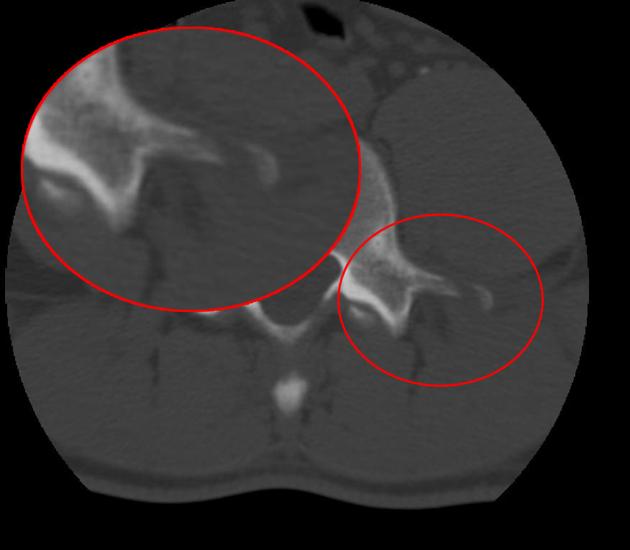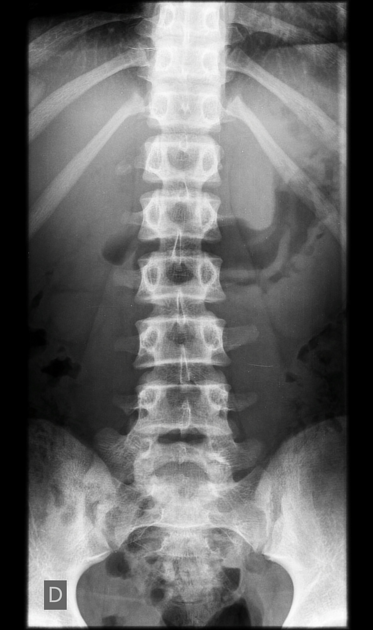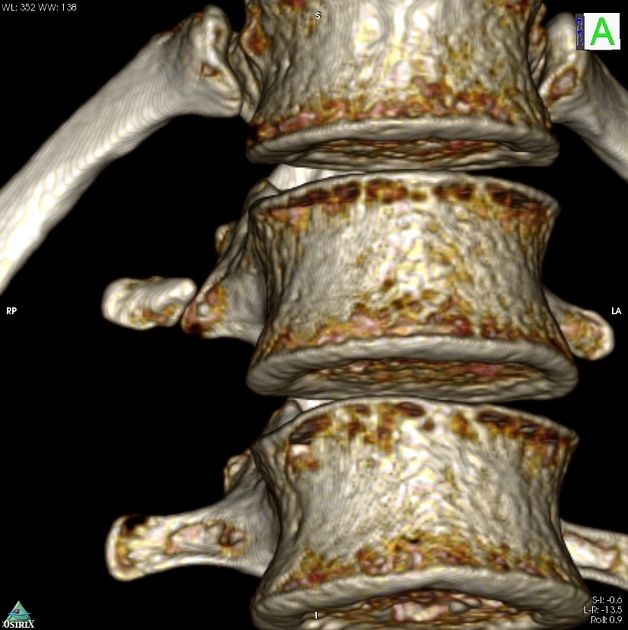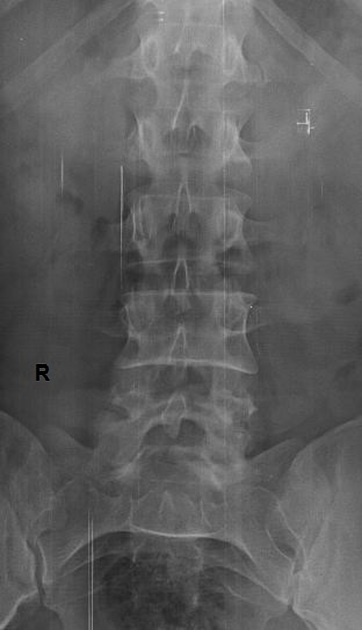Transverse process fracture
Citation, DOI, disclosures and article data
At the time the article was created Henry Knipe had no recorded disclosures.
View Henry Knipe's current disclosuresAt the time the article was last revised Joachim Feger had no recorded disclosures.
View Joachim Feger's current disclosures- Transverse process fractures
Transverse process fractures are common sequelae of trauma, although they are considered minor and stable lumbar spine fractures. There is a strong association between transverse process fractures and other traumatic injuries.
On this page:
Pathology
Transverse process fracture most commonly occurs in the upper lumbar spine and are commonly multiple 2. The fracture line can extend into the transverse foramen, and in the cervical spine, there is a risk of complicating vertebral artery dissection.
Etiology
- blunt trauma
- lateral flexion-extension injury
- psoas muscle avulsion
- Malgaigne pelvic fracture
Associations
Although a minor injury to the lumbar spine, transverse process fractures require major force:
- cervical transverse process fractures have a strong association with other cervical spine fractures 2 and blunt cerebrovascular injury
- ~35% (range 20-50%) of patients with lumbar transverse process fractures have hepatic and splenic injuries, genitourinary and/or diaphragmatic injuries 1
Radiographic features
CT is the modality of choice. Up to 60% of lumbar transverse process fractures identified on CT will be missed on plain radiographs 1.
Differential diagnosis
In the lumbar region, consider anatomical variants such as:
References
- 1. Patten R, Gunberg S, Brandenburger D. Frequency and Importance of Transverse Process Fractures in the Lumbar Vertebrae at Helical Abdominal CT in Patients with Trauma. Radiology. 2000;215(3):831-4. doi:10.1148/radiology.215.3.r00jn27831 - Pubmed
- 2. Neil E. Green. Skeletal Trauma in Children. (2009) ISBN: 9781416049005 - Google Books
- 3. Dennis M. Marchiori. Clinical Imaging. (2005) ISBN: 9780323022644 - Google Books
Incoming Links
- Unfused transverse process ossification center of L1 vertebra
- Crush injury
- Hypoplastic right 12th rib
- Extrapleural fat sign
- Hereditary multiple exostoses (HME) and pelvic trauma
- Multiorgan trauma with CT features of hypotension
- Multitrauma with diaphragmatic rupture
- Multitrauma: intracranial, spinal, thoracic and pelvic injuries
- Gunshot injury to the abdomen
- Lumbar transverse process fractures
- Odontoid fracture - type III
- Transverse process fracture
Related articles: Fractures
-
fracture
- terminology[+][+]
- fracture location
- diaphyseal fracture
- metaphyseal fracture
- physeal fracture
- epiphyseal fracture
- fracture types
- avulsion fracture
- articular surface injuries
- complete fracture
- incomplete fracture
- infraction
- compound fracture
- pathological fracture
- stress fracture
- fracture displacement
- fracture location
- fracture healing[+][+]
- skull fractures[+][+]
-
facial fractures[+][+]
- fractures involving a single facial buttress
- alveolar process fractures
- frontal sinus fracture
- isolated zygomatic arch fractures
- mandibular fracture
- nasal bone fracture
- orbital blow-out fracture
- paranasal sinus fractures
- complex fractures
- dental fractures
- fractures involving a single facial buttress
-
spinal fractures
- classification (AO Spine classification systems)[+][+]
-
cervical spine fracture classification systems
- AO classification of upper cervical injuries
- AO classification of subaxial injuries
- Anderson and D'Alonzo classification (odontoid fracture)
- Roy-Camille classification (odontoid process fracture)
- Gehweiler classifcation (atlas fractures)
- Levine and Edwards classification (hangman fracture)
- Allen and Ferguson classification (subaxial spine injuries)
- subaxial cervical spine injury classification (SLIC)
- thoracolumbar spinal fracture classification systems
- three column concept of spinal fractures (Denis classification)
- classification of sacral fractures
-
cervical spine fracture classification systems
- spinal fractures by region
- spinal fracture types[+][+]
- classification (AO Spine classification systems)[+][+]
- rib fractures[+][+]
- sternal fractures
-
upper limb fractures[+][+]
- classification
- Rockwood classification (acromioclavicular joint injury)
- AO classification (clavicle fracture)
- Neer classification (clavicle fracture)
- Neer classification (proximal humeral fracture)
- AO classification (proximal humeral fracture)
- AO/OTA classification of distal humeral fractures
- Milch classification (lateral humeral condyle fracture)
- Weiss classification (lateral humeral condyle fracture)
- Bado classification of Monteggia fracture-dislocations (radius-ulna)
- Mason classification (radial head fracture)
- Frykman classification (distal radial fracture)
- Mayo classification (scaphoid fracture)
- Hintermann classification (gamekeeper's thumb)
- Eaton classification (volar plate avulsion injury)
- Keifhaber-Stern classification (volar plate avulsion injury)
- upper limb fractures by region
- shoulder
- clavicular fracture
-
scapular fracture
- acromion fracture
- coracoid process fracture
- glenoid fracture
- humeral head fracture
- proximal humeral fracture
- humeral neck fracture
- arm
- elbow
- forearm
- wrist
-
carpal bones
- scaphoid fracture
- lunate fracture
- capitate fracture
- triquetral fracture
- pisiform fracture
- hamate fracture
- trapezoid fracture
- trapezium fracture
- hand
- shoulder
- classification
- lower limb fractures[+][+]
- classification by region
- pelvic fractures
- hip fractures
- Pipkin classification (femoral head fracture)
- Garden classification (hip fracture)
- American Academy of Orthopedic Surgeons classification (periprosthetic hip fracture)
- Cooke and Newman classification (periprosthetic hip fracture)
- Johansson classification (periprosthetic hip fracture)
- Vancouver classification (periprosthetic hip fracture)
- femoral
- knee
- Schatzker classification (tibial plateau fracture)
- AO classification of distal femur fractures
- Meyers and McKeevers classification (anterior cruciate ligament avulsion fracture)
- tibia/fibula
- Watson-Jones classification (tibial tuberosity avulsion fracture)
- ankle
- foot
- Berndt and Harty classification (osteochondral lesions of the talus)
- Sanders CT classification (calcaneal fracture)
- Hawkins classification (talar neck fracture)
- Myerson classification (Lisfranc injury)
- Nunley-Vertullo classification (Lisfranc injury)
- pelvis and lower limb fractures by region
- pelvic fracture
- sacral fracture
- coccygeal fracture
-
hip
- acetabular fracture
- femoral head fracture
-
femoral neck fracture
- subcapital fracture
- transcervical fracture
- basicervical fracture
-
trochanteric fracture
- pertrochanteric fracture
- intertrochanteric fracture
- subtrochanteric fracture
- femur
- mid-shaft fracture
- bisphosphonate-related fracture
- distal femoral fracture
- knee
- avulsion fractures
- Segond fracture
- reverse Segond fracture
- anterior cruciate ligament avulsion fracture
- posterior cruciate ligament avulsion fracture
- arcuate complex avulsion fracture (arcuate sign)
- biceps femoris avulsion fracture
- iliotibial band avulsion fracture
- semimembranosus tendon avulsion fracture
- Stieda fracture (MCL avulsion fracture)
- patellar fracture
- tibial plateau fracture
- avulsion fractures
- leg
- tibial tuberosity avulsion fracture
- tibial shaft fracture
- fibular shaft fracture
- Maisonneuve fracture
- ankle
- foot
- tarsal bones
- metatarsal bones
- phalanges
- classification by region
- terminology[+][+]
Related articles: Spinal trauma
-
spinal fractures
- morphology[+][+]
- fractures by location
- cervical spine fracture[+][+]
-
thoracolumbar spine fracture
- Chance fracture
- transverse process fracture
- spondylolysis
- limbus fractures
- sacral fracture[+][+]
- classifications[+][+]
- AO spine classification systems
- three column concept of spinal fractures (Denis classification)
-
cervical spine fracture classification systems
- upper cervical spine
- AO Spine classification of upper cervical injuries
- occipital condyle and occipital cervical junction
- atlas (C1) and C1-2 joint
- axis (C2) and C2-3 joint
- Roy-Camille classification (dens)
- Anderson and D'Alonzo classification (dens)
- Levine and Edwards classification (pars interarticularis)
- subaxial cervical spine
- upper cervical spine
- thoracolumbar spinal fracture classification systems
- classifications of sacral fractures
- facet dislocation[+][+]
- listhesis[+][+]











 Unable to process the form. Check for errors and try again.
Unable to process the form. Check for errors and try again.